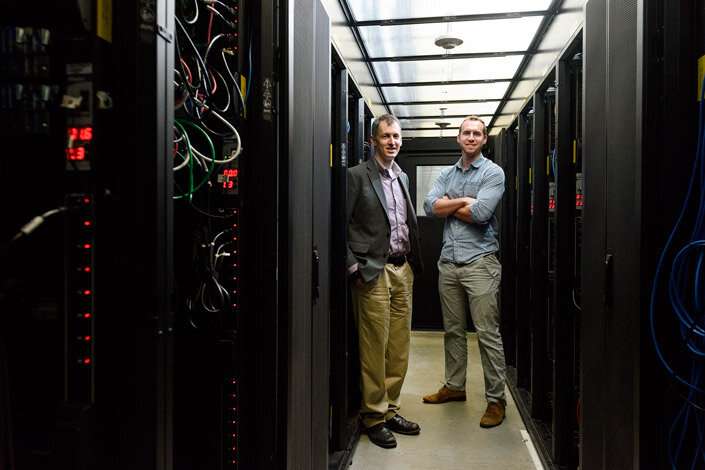Scientists identify solid electrolyte materials that boost lithium-ion battery performance

Stanford University scientists have identified a new class of solid materials that could replace flammable liquid electrolytes in lithium-ion batteries.
The low-cost materials—made of lithium, boron and sulfur—could improve the safety and performance of electric cars, laptops and other battery-powered devices, according to the scientists. Their findings are published in a study in the journal ACS Applied Materials & Interfaces.
"A typical lithium-ion battery has two solid electrodes with a highly flammable liquid electrolyte in between," said study lead author Austin Sendek, a visiting scholar in Stanford's Department of Materials Science & Engineering. "Our goal is to design stable, low-cost solid electrolytes that also increase the power and energy output of the battery."
Promising materials
Battery electrolytes shuttle lithium ions between the positive and negative electrode during charging and discharging. Most lithium-ion batteries use a liquid electrolyte that can combust if the battery is punctured or short-circuited. Solid electrolytes, on the other hand, rarely catch fire and are potentially more efficient.
"Solid electrolytes hold promise as safer, longer-lasting and more energy-dense alternatives to liquid electrolytes," said senior author Evan Reed, an associate professor of materials science and engineering. "However, the discovery of suitable materials for use in solid electrolytes remains a significant engineering challenge."
Most solid electrolytes in use today are too unstable, inefficient and expensive to be commercially viable, the authors said.
"Conventional solid electrolytes can't conduct as much ionic current as liquid electrolytes," Sendek said. "The few that can usually degrade once they come in contact with the battery electrodes."
Machine learning
To find reliable solid electrolytes, Sendek and his colleagues in 2016 trained a computer algorithm to screen more than 12,000 lithium-containing compounds in a materials database. Within minutes the algorithm identified approximately 20 promising materials, including four little-known compounds made of lithium, boron and sulfur.
"As we were looking at the candidates, we noticed that four lithium-boron-sulfur compounds kept popping up," Sendek said. "Unfortunately, there wasn't much about these materials in the existing scientific literature."
In the current study, the researchers took a closer look at the four compounds using a technique called density functional theory, which simulates how the materials would behave at the atomic level.
Very promising results
Lithium-boron-sulfur electrolytes could be about twice as stable as the leading solid electrolytes, the current study shows. Stability can impact the amount of energy per unit weight a battery can store. In electric vehicles, that can mean a longer driving range.
"Teslas and other electric cars can go 250 to 300 miles on a single charge." Sendek said. "But with a solid electrolyte you could potentially double the energy density of lithium-ion batteries and get that range above 500 miles—and maybe even start thinking about electric flight."
When a typical solid electrolyte breaks down, it chemically transforms from a good conductor into a bad conductor, causing the battery to stop working. The study predicted that when mixed together, the four lithium-boron-sulfur compounds would continue functioning even as they decompose.
"All four compounds are chemically similar," Sendek said. "So when the mixture breaks down, each compound will likely transform from a good conductor to another good conductor to another. That means the materials can withstand several cycles of breaking down before they decompose into a bad conductor that ultimately kills your battery."
The study also predicted that certain phases of the lithium-boron-sulfur materials could be three times better at conducting lithium ions than state-of-the-art solid electrolytes made with costly germanium.
"If you get good ionic conductivity you can get more current flow out of your battery," Sendek said. "More current means more power to accelerate your car."
Some of the best solid electrolytes available today are made with rare elements like germanium, a kilogram of which costs about $500. Lithium, boron and sulfur are abundant chemicals with a price tag of $26 per kilogram.
"Our computer algorithm was searching for new materials based on their physical properties," Sendek said. "But it just so happened the four compounds were also much cheaper than the alternatives."
Lithium metal
Finding a viable solid electrolyte could also lead to the development of lithium metal batteries—energy-dense, lightweight batteries that are ideal candidates for electric cars.
Most lithium-ion batteries have a negatively charged electrode made of graphite. In lithium metal batteries, graphite is replaced with metallic lithium, which can store significantly more charge per kilogram.
"Lithium metal is really the holy grail of battery research," Sendek said. "But lithium metal electrodes have a tendency to internally short during operation, which liquid electrolytes do nothing to prevent. Solid electrolytes seem to be our best chance of overcoming that problem, and lithium-boron-sulfur electrolytes are promising candidates."
Research roadmap
The Stanford study provides a theoretical roadmap for future research. The next step is to synthesize all four lithium-boron-sulfur materials and test them in a battery.
"From what my experimentalist friends tell me, making these materials in the lab may be quite difficult," Sendek said. "Our job as theorists is to point the experimentalists to promising materials and let them see how the materials perform in real devices."
The ability to identify these promising materials from thousands of candidates was made possible through artificial intelligence and machine learning, Reed added.
"The discovery of most new materials to date has been accomplished by inefficient trial-and-error searches," he said. "Our results represent an inspiring success for the machine-learning approach to materials chemistry."
More information: Austin D. Sendek et al, Combining Superionic Conduction and Favorable Decomposition Products in the Crystalline Lithium–Boron–Sulfur System: A New Mechanism for Stabilizing Solid Li-Ion Electrolytes, ACS Applied Materials & Interfaces (2020). DOI: 10.1021/acsami.9b19091


















